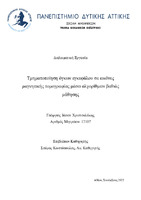| dc.contributor.advisor | Kostopoulos, Spiros | |
| dc.contributor.author | Χριστουλάκης, Γεώργιος Ιάσων | |
| dc.date.accessioned | 2022-10-13T12:38:36Z | |
| dc.date.available | 2022-10-13T12:38:36Z | |
| dc.date.issued | 2022-10-11 | |
| dc.identifier.uri | https://polynoe.lib.uniwa.gr/xmlui/handle/11400/3067 | |
| dc.identifier.uri | http://dx.doi.org/10.26265/polynoe-2907 | |
| dc.description.abstract | Τα χαμηλού βαθμού γλοιώματα (LGG) στον εγκέφαλο είναι όγκοι του κεντρικού νευρικού συστήματος που παρουσιάζουν διακύμανση στην επιθετικότητα της ανάπτυξης. Ο μαγνητικός συντονισμός είναι η μέθοδος απεικόνισης εκλογής για τη διάγνωση των LGG. Τα χαρακτηριστικά του όγκου μπορεί να παρέχουν σημαντικές πληροφορίες πριν από τη χειρουργική επέμβαση και όταν η εκτομή δεν είναι δυνατή. Κατά συνέπεια, η αναγνώριση και η ακριβής κατάτμηση των όγκων παρέχουν τη βάση για περαιτέρω ανάλυση. Πρόσφατα, οι μέθοδοι βαθιάς μάθησης (DL) παρείχαν τα εργαλεία για την αυτόματη αναγνώριση και τμηματοποίηση των όγκων του εγκεφάλου.
Πειραματιστήκαμε με ένα σύνολο δεδομένων MRI εγκεφάλου LGG που λήφθηκε από το kaggle.com ως "LGG Segmentation Dataset" και αποτελείται από 3929 εικόνες MRI σε ακολουθία T2-FLAIR, που περιέχουν εικόνες με όγκους, μη όγκους και τις αντίστοιχες μάσκες με τους περιγεγραμμένους όγκους εγκεκριμένες από επιτροπή ραδιολόγων στο Πανεπιστήμιο Duke. Εφαρμόσαμε τρία διαφορετικά μοντέλα DL για να εκτελέσουμε τμηματοποίηση εικόνας βάσει pixel. τα μοντέλα U-NET, Residual U-NET και Attention U- NET. Τέλος, και προκειμένου να βελτιώσουμε την απόδοση τμηματοποίησης, χρησιμοποιήσαμε ένα μοντέλο συνόλου (EDL) χρησιμοποιώντας τεχνική hard voting. Οι εικόνες χωρίστηκαν για 70% εκπαίδευση και 10% test ενώ το 20% έμεινε εκτός για σκοπούς validaation, έτσι ώστε να εκτιμηθεί η ικανότητα γενίκευσης της προτεινόμενης μεθόδου. Όλα τα μοντέλα εκπαιδεύτηκαν σε cloud server με ισχυρές GPU.
Η μέθοδoς μας εντοπίζει την παρουσία όγκου LGG κατά 97,6% ενώ υστερεί σε ποσοστό 1,5% στο validation set. Όσο αφορά την κατάτμηση, το μοντέλο EDL ξεπερνά τα υπόλοιπα μοντέλα που δοκιμάστηκαν όσο αφορά τα μετρικά Precision, Jaccard και Dice με 0.88±0.15, 0.74±0.19 και 0.83±0.16 αντίστοιχα, που είναι συγκρίσιμο, αν όχι ελαφρώς υψηλότερο, με τις προηγούμενες δημοσιευμένες μελέτες.
Παρά την υψηλή ετερογένεια των όγκων, η προτεινόμενη μέθοδος προσδιορίζει σωστά την παρουσία ενός όγκου LGG και τον τμηματοποιεί με υψηλή ακρίβεια σε άγνωστα δεδομένα. | el |
| dc.format.extent | 101 | el |
| dc.language.iso | el | el |
| dc.publisher | Πανεπιστήμιο Δυτικής Αττικής | el |
| dc.rights | Αναφορά Δημιουργού - Μη Εμπορική Χρήση - Παρόμοια Διανομή 4.0 Διεθνές | * |
| dc.rights | Attribution-NoDerivatives 4.0 Διεθνές | * |
| dc.rights.uri | http://creativecommons.org/licenses/by-nd/4.0/ | * |
| dc.subject | Χαμηλού βαθμού γλοίωμα | el |
| dc.subject | Μαγνητική Τομογραφία (MRI) | |
| dc.subject | Τμηματοποίηση | |
| dc.subject | U-NET | |
| dc.subject | Βαθιά μάθηση | |
| dc.title | Τμηματοποίηση όγκων εγκεφάλου σε εικόνες μαγνητικής τομογραφίας μέσω αλγορίθμων βαθιάς μάθησης | el |
| dc.title.alternative | Segmentation of brain tumours in MR images using deep learning algorithms | el |
| dc.type | Διπλωματική εργασία | el |
| dc.contributor.committee | Glotsos, Dimitris | |
| dc.contributor.committee | Asvestas, Pantelis | |
| dc.contributor.faculty | Σχολή Μηχανικών | el |
| dc.contributor.department | Τμήμα Μηχανικών Βιοϊατρικής | el |
| dc.description.abstracttranslated | Low-grade gliomas (LGGs) in the brain are tumors of the central nervous system that exhibit variance in growth aggressiveness. Magnetic resonance is the imaging modality of choice for the diagnosis of LGGs. Tumor’s characteristics may give important information before surgery and when resection is not possible. Consequently, identification and accurate segmentation of tumors provide the basis for further analysis. Recently, deep learning (DL) methods have provided the tools for automatic identification and segmentation of brain tumors.
We have experimented with a LGG brain MRI dataset that was downloaded from kaggle.com as “LGG Segmentation Dataset”, and consists of 3929 MRI images in T2-FLAIR sequence, containing images with tumors, non-tumors and the corresponding manually delineated abnormality masks approved by a board-certified radiologist at Duke University. We applied three different DL models to perform pixel-based image segmentation; the U-NET, the Residual U-NET and the Attention U-NET DL models. Finally, and in order to improve segmentation performance we have employed an ensemble model (EDL) using hard voting. The images were split for 70% training and 10% testing, while 20% were left out for validation purposes, so as to estimate the generalization capability of the proposed method. All models were trained on cloud server with powerful GPUs.
Our method identifies the presence of an LGG tumor by 97.6% while it misses by 1.5% rate in validation stage.
Concerning segmentation, the EDL model outperforms the rest of the models tested in terms of the Precision, Jaccard and Dice metrics with 0.88±0.15, 0.74±0.19 and 0.83±0.16 respectively that is comparable, if not slightly higher, to the previously published studies.
Despite the high heterogeneity of the tumors, the proposed method identifies correctly the presence of an LGG tumor and it segmented it by high precision in unseen data. | el |


